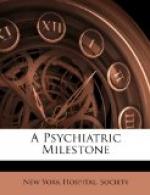The study of life problems always concerns itself with the interaction of an individual organism with life situations. The first result of a recognition of this fact was a more whole-hearted and practical concept of personality.
In 1903 I put together for the first time my analysis of the neurotic personality, which was soon followed by a series of studies on the influences of the mental factors, and in 1908 a paper on “What Do Histories of Cases of Insanity Teach Us Concerning Preventive Mental Hygiene During the Years of School Life?” All this was using for psychiatry the growing appreciation of a broad biological view-point in its concrete application. It was a reaction against the peculiar fear of studying the facts of life simply and directly as we find and experience them—scoffed at because it looked as if one was not dealing with dependable and effective data. Many of the factors mentioned as causes do not have the claimed effects with sufficient regularity. It is quite true that not everybody is liable to any serious upset by several of the handicaps sometimes found to be disastrous during the years of development; but we have learned to see more clearly why the one person does and the other does not suffer. Evidently, not everybody who is reserved and retiring need be in danger of mental disorder, yet there are persons of just this type of make-up that are less able than others to stand the strains of isolation, of inferiority feeling, of exalted ambitions and one-sided longings, intolerable desires, etc. The same individual difference of susceptibility holds even for alcohol. With this recognition we came to lay stress again on the specific factors which make for the deterioration of habits, for tantrums with imaginations, and for drifting into abnormal behavior, and conditions incompatible with health.
It was at this point that our great indebtedness to the Bloomingdale Hospital began. Dr. August Hoch, then First Assistant of the Bloomingdale Hospital, began to swing more and more toward the psychobiological trend of views, and with his devoted and very able friend Amsden he compiled that remarkable outline,[2] which was the first attempt to reduce the new ideals of psychobiology to a practical scheme of personality study—that clear and plain questionnaire going directly at human traits and reactions such as we all know and can see at work without any special theories or instruments.
After studying in each patient all the non-mental disorders such as infections, intoxications, and the like, we can now also attack the problems of life which can be understood only in terms of plain and intelligible human relations and activities, and thus we have learned to meet on concrete ground the real essence of mind and soul—the plain and intelligible human activities and relations to self and others. There are in the life records of our patients certain ever-returning tendencies and situations which a psychiatry of exclusive brain speculation, auto-intoxications, focal infections, and internal secretions could never have discovered.




